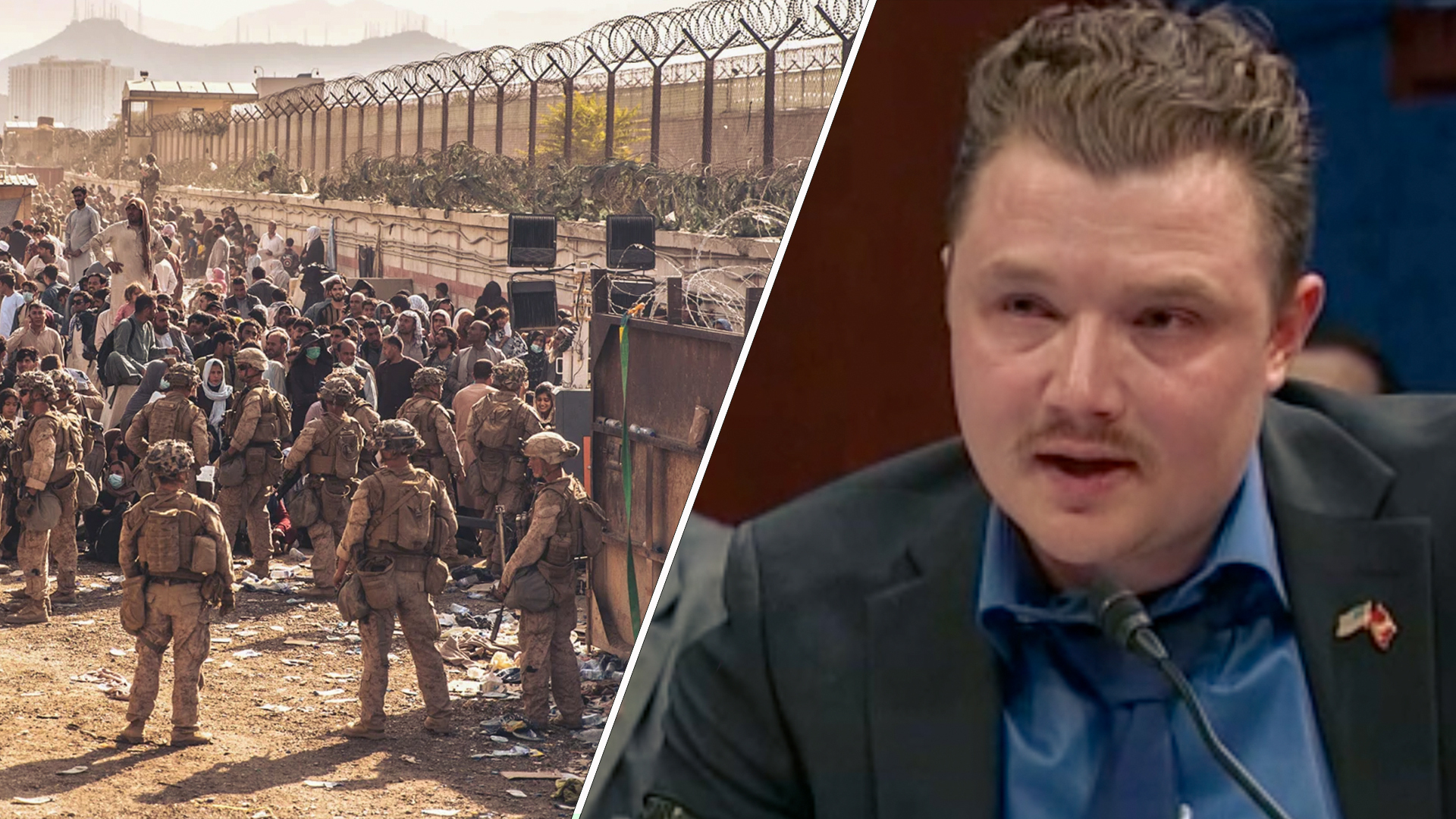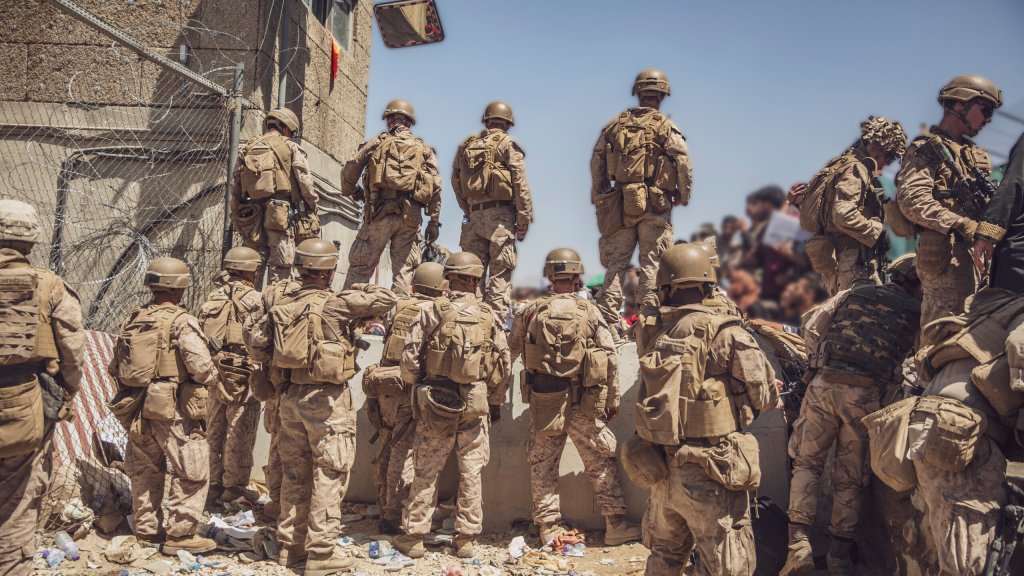

The U.S. troops who guarded Hamid Karzai International Airport’s Abbey Gate during the chaotic withdrawal from Afghanistan witnessed nothing short of hell on earth, a wounded Marine told lawmakers on Wednesday.
“People were suffering from extreme malnutrition, dehydration, heat casualties, and infants were dying,” Marine Sgt. Tyler Vargas-Andrews told the House Foreign Affairs Committee. “Afghans [who] were brutalized and tortured by the Taliban flocked to us, pleading for help. Some Afghans turned away from HKIA [Hamid Karzai International Airport] tried to kill themselves on the razor wire in front of us that we used as a deterrent. They thought this was merciful compared to the Taliban torture that they faced.”

Vargas-Andrews, who was part of a Scout Sniper team at the time, spent seven days at Abbey Gate. On Aug. 26, 2021, he lost his right arm and left leg when a suicide bomber detonated 20 pounds of explosives outside the gate, killing 13 U.S. service members and nearly 200 Afghans.
Subscribe to Task & Purpose Today. Get the latest military news, entertainment, and gear in your inbox daily.
On Wednesday, Vargas-Andrews gave lawmakers a searing account of the events leading up to and immediately following the suicide bomber attack as part of the congressional hearing into the Afghan evacuation. He made clear that he was speaking for himself, not on behalf of the Marine Corps or Defense Department.
On Aug. 19, 2021, Vargas-Andrews’ team set up a position at Abbey Gate, where tens of thousands of desperate people descended and tried to push their way through the gate in successive waves, he said.

“The next seven days were surreal,” said Vargas-Andrews, who is currently stationed at Wounded Warrior Detachment, Walter Reed Medical Center in Bethesda, Maryland. “Nothing prepared us for the ground experience we were about to encounter. It was chaos, but we worked together to figure out the next best steps.”
The Marines and other service members guarding Abbey Gate were looking for people in the crowd who were holding blue American passports, Vargas-Andrews said.
After the Taliban captured Kabul on Aug. 15, 2021, Marine Gen. Kenneth McKenzie Jr., head of Central Command, struck a deal with Abdul Ghani Baradar, the Taliban’s top political leader, that U.S. troops would provide security at Kabul’s airport during the evacuation and the Taliban would control the rest of the city.
That meant that thousands of Afghans and Americans had to run through a gauntlet of Taliban checkpoints before they reached one of the gates at Hamid Karzai International Airport.
Vargas-Andrews told lawmakers that the Taliban killed “countless Afghans” just 155 yards in front of the Marines’ position, but U.S. service members were unable to do anything in response.

“With only shipping containers between us, the Taliban would routinely murder people under our observation at their checkpoint,” Vargas-Andrews said. “We communicated the atrocities to our chain of command and intel assets, but nothing came of it.”
State Department personnel oversaw the processing of people trying to get into the airport, but were simply unprepared to deal with the urgent situation, Vargas-Andrews said.
While U.S. troops remained at Abbey Gate 24 hours a day, State Department personnel would stop processing people overnight, “leaving ground forces with a nightmare,” Vargas-Andrews said.
“In fact, State would not want to deal with the Afghans unable to be processed,” Vargas-Andrews said. “Weakening the security of the perimeter, State would take us away from our mission to walk Afghans out to meet the fate of the Taliban, condemning them to death.”
The U.S. troops at Abbey Gate were in such an exposed and unprotected position that Marine Brig. Gen. Farrell Sullivan who led the joint task force crisis response at Kabul Airport had wanted to close Abbey Gate on the evening of Aug. 25, 2021, an investigation into the suicide bomb attack later found.

Then-Army Maj. Gen. Christopher Donahue, who led the 82nd Airborne Division at the time, ultimately kept Abbey Gate open until Aug. 27, 2021, after British Brig. Gen. James Martin told him that British forces needed more time to complete their evacuation efforts at the nearby Baron Hotel, the investigation found.
Vargas-Andrews said he believes that his team spotted the suicide bomber before he could detonate his device outside Abbey Gate, but military leaders did not allow Marines to shoot the man.
On Aug. 26, 2021, U.S. intelligence officials told American troops that a suicide bomber was near Abbey Gate. He was described as clean-shaven, wearing a black vest, and traveling with an older companion, he said.
Vargas-Andrews said that when he asked why the man had not already been apprehended if intelligence officials knew what he looked like, he was told: “the asset could not be compromised.”
Later, Vargas-Andrews and two other Marines spotted a man matching the description of the suicide bomber with an older companion, so they reported an improvised explosive device attack was imminent.
“This was as serious as it could get,” he said.

But when Vargas-Andrews asked for permission to shoot the man, he was told not to engage because his leadership did not have the necessary authority to do so, he said.
Vargas-Andrews said he then asked for his battalion commander to come to the scene, but the lieutenant colonel told them he did not know if they could shoot the suspected bomber. The officer said he would find out who could authorize the Marines to shoot the man who matched the suicide bomber’s description, but they never heard back from anyone.
“Plain and simple: We were ignored,” Vargas-Andrews said. “Our expertise was disregarded. No one was held accountable for our safety.”
Vargas-Andrews struggled to contain his emotions as he explained how the suspected suicide bomber disappeared and he later went into the crowd to find an Afghan interpreter.
While waiting for the interpreter’s family to arrive, Vargas-Andrews saw a flash and felt a massive wave of pressure. Even though he was thrown to the ground 12 feet away, he immediately knew what had happened.

“I opened my eyes to Marines dead or unconscious lying around me,” Vargas-Andres said before wiping the tears from his eyes and taking a few seconds to compose himself. “A crowd of hundreds immediately vanished in front of me, and my body was catastrophically wounded with 100 to 150 ball bearings now in it.”
He heard gunshots and saw that his right arm was “completely shredded and unusable” and his abdomen had been ripped open and was soaked with blood.
Vargas-Andrews was unable to get up. He started to lose consciousness but then he heard his team leader screaming his name.
“His voice calling to me kept me awake,” Vargas-Andrews said, pausing for several seconds to wipe his eyes with a tissue before he continued. “When he got to me, he dragged me to safety and immediately started triaging me, tying tourniquets on my limbs and doing anything he could to stop the bleeding and start plugging wounds with the help of other Marines.”
Vargas-Andrews finished his testimony by making clear that he feels the U.S. government failed the 13 service members who died at Abbey Gate.
“The withdrawal was a catastrophe, in my opinion, and there was an inexcusable lack of accountability and negligence,” Vargas-Andrews said. “The 11 Marines, one sailor, and one soldier that were murdered that day have not been answered for.”
The latest on Task & Purpose
- The Marine Corps is getting rid of Scout Snipers
- Air Force relieves 2 commanders and 4 subordinates at Minot Air Force Base
- Why mortars are increasingly important on the modern battlefield
- American vet who claims he defected to Russia in Ukraine served just 2 years in the US Army, left as PFC
- How an Air Force captain was court-martialed for hanging up on a colonel
Want to write for Task & Purpose? Click here.
